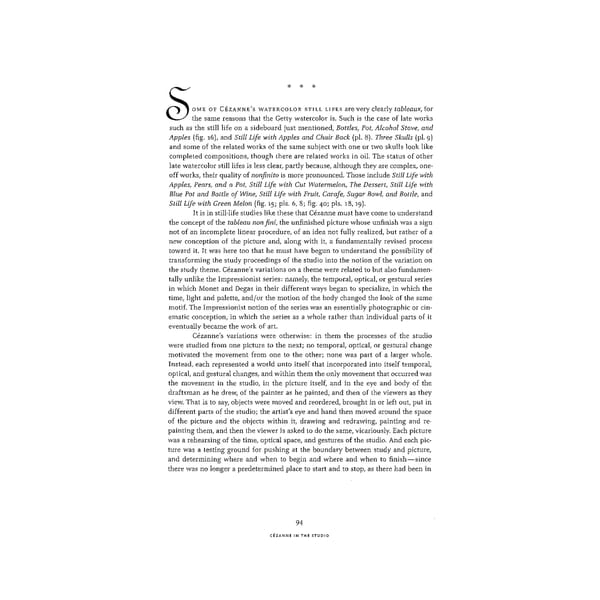OME OF CEZANNE'S WATERCOLOR STILL LIFES are very clearly tableaux, for S the same reasons that the Getty watercolor is. Such is the case of late works such as the still life on a sideboard just mentioned, Bottles, Pot, Alcohol Stove, and Apples (fig. 16), and Still Life with Apples and Chair Back (pi. 8). Three Skulls (pi. 9) and some of the related works of the same subject with one or two skulls look like completed compositions, though there are related works in oil. The status of other late watercolor still lifes is less clear, partly because, although they are complex, one- off works, their quality of nonfinito is more pronounced. Those include Still Life with Apples, Pears, and a Pot, Still Life with Cut Watermelon, The Dessert, Still Life with Blue Pot and Bottle of Wine, Still Life with Fruit, Carafe, Sugar Bowl, and Bottle, and Still Life with Green Melon (fig. 15; pis. 6, 8; fig. 40; pis. 18,19). It is in still-life studies like these that Cézanne must have come to understand the concept of the tableau non fini, the unfinished picture whose unfinish was a sign not of an incomplete linear procedure, of an idea not fully realized, but rather of a new conception of the picture and, along with it, a fundamentally revised process toward it. It was here too that he must have begun to understand the possibility of transforming the study proceedings of the studio into the notion of the variation on the study theme. Cezanne's variations on a theme were related to but also fundamen- tally unlike the Impressionist series: namely, the temporal, optical, or gestural series in which Monet and Degas in their different ways began to specialize, in which the time, light and palette, and/or the motion of the body changed the look of the same motif. The Impressionist notion of the series was an essentially photographic or cin- ematic conception, in which the series as a whole rather than individual parts of it eventually became the work of art. Cezanne's variations were otherwise: in them the processes of the studio were studied from one picture to the next; no temporal, optical, or gestural change motivated the movement from one to the other; none was part of a larger whole. Instead, each represented a world unto itself that incorporated into itself temporal, optical, and gestural changes, and within them the only movement that occurred was the movement in the studio, in the picture itself, and in the eye and body of the draftsman as he drew, of the painter as he painted, and then of the viewers as they view. That is to say, objects were moved and reordered, brought in or left out, put in different parts of the studio; the artist's eye and hand then moved around the space of the picture and the objects within it, drawing and redrawing, painting and re- painting them, and then the viewer is asked to do the same, vicariously. Each picture was a rehearsing of the time, optical space, and gestures of the studio. And each pic- ture was a testing ground for pushing at the boundary between study and picture, and determining where and when to begin and where and when to finish—since there was no longer a predetermined place to start and to stop, as there had been in 94 CÉZANNE IN THE STUDIO
 Cézanne in the Studio: Still Life in Watercolors Page 108 Page 110
Cézanne in the Studio: Still Life in Watercolors Page 108 Page 110